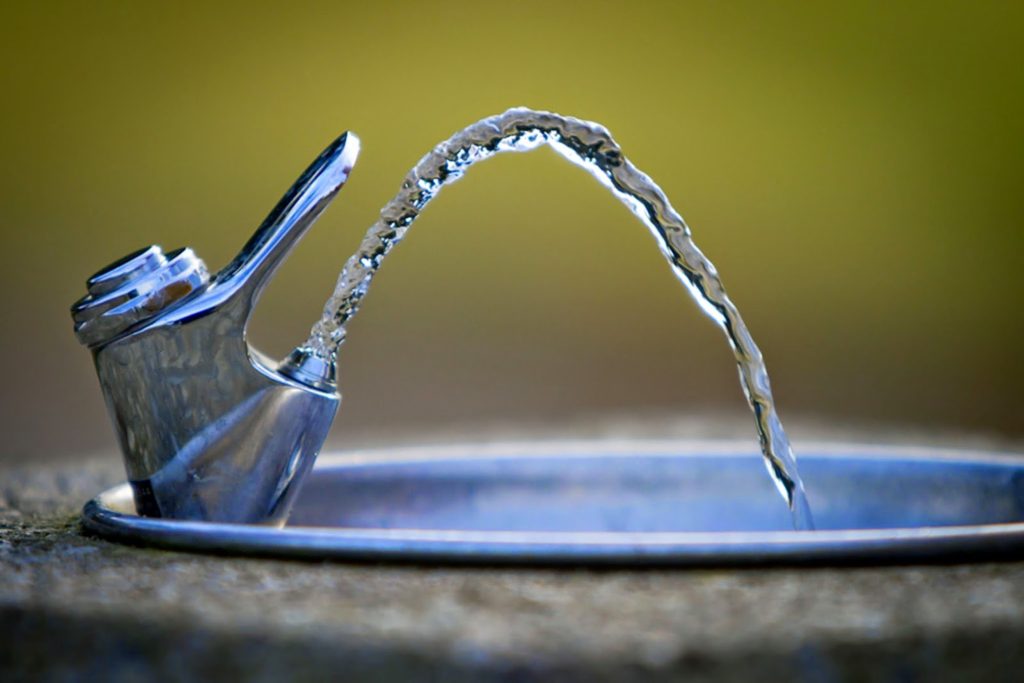 By Staff
By Staff
September 5, 2018
BURLINGTON, ON
A Gazette reader advised us that parents were getting notices about the amount of lead in the water in Halton Board of Education schools.
We asked Director of Education Stuart Miller the following questions:
What’s with the lead in the water at MMR?
How bad is it?
When did the Board learn about it?
What is the Board doing about it?
The Board of Education has it all under control.
David Boag, Associate Director of Education told that Gazette that lead testing occurs throughout the school year in all our schools.

David Boag, Associate Director of Education at the Halton District School Board
In each school testing occurs at several locations (different fixtures) within the school. This testing occurred this summer and in some schools, lead concentrations were above allowable limits. Where this occurs, we inform families. This often occurs in the summer when water is allowed to sit in pipes and our regular flushing routine is not in effect at many sites.
Wherever there is a lead exceedacne, flushing occurs and the water is tested again. If the fixture where the test was done does not pass after flushing, the fixture is taken out of service and further maintenance or replacement occurrs.
All other locations must achieve a passing test for the fixture to be put back in service. Prior to school coming back for September we resume our daily water flushing to ensure water quality for staff and students in our schools.
The Ministry of the Environment, Conservation and Parks requires all sites to be tested annually between May and October. The Halton District School Board hires an independent, certified third-party to gather water samples and send to a certified laboratory to perform the analysis. Under the regulation, if an exceedance is detected, the lab is required to inform the Ministry of Environment Spills Action Centre, the Ministry of the Environment, Conservation and Parks, Halton Region Public Health Department, the Ministry of Education and the school board.
If a fixture’s standing sample laboratory test results indicate an unacceptable concentration of lead and the flushed sample shows acceptable lead concentration levels, staff at the school perform a five-minute daily flush of every water line, and a ten-second flush at every fixture before school starts. This ensures the standing water condition does not occur. If a fixture’s flushed sample laboratory test results indicate an unacceptable concentration of lead, water supply to the fixture is shut off.

Pure clear water – tested regularly
The water supply is not turned back on until two consecutive tests are conducted and the results show the lead concentration within the water is safe to drink. Adjacent water fixtures are also tested to ensure the issue is not present within the supplying water line. If subsequent test results show unacceptable concentration levels, the fixture is either removed entirely or replaced and retested. In the event that there has been an exceedance, flushing will occur daily for a period of two years as a precaution. This applies to both standing and flush test results.
The drinking water at schools within the Halton District School Board follows stringent water testing in accordance with Ontario Regulation 243/07 and under the direction of the Ministry the Environment, Conservation and Parks. All sampling, testing and any remediation is completed before school commences to ensure the health and safety of students.
They’ve got this one under control.



















The city is aware lead pipes are leaching lead into school water. What is being done to fix the problem? Flushing is a band aid solution.
How is this under control? What is considered to be an acceptable lead concentration level? Where can parents access the results of these tests? How do we have proof the flushing is being performed? This article appears written by a biased party.
We use a filtering system that is installed under our sink for drinking and cooking. We use special filters on the shower, and hope for the best. I store water in glass or stainless steel containers. I never drink from plastic bottles especially those sitting in the sun like at gas stations. I have been tested for heavy metals and already know my levels of lead and mercury are at the higher end. I’m not too keen on fountains and don’t put ice in drinks at restaurants. I also would prefer fluoride out of drinking water due to thyroid issues but that is a personal choice.
This article raises some questions regarding the actions and reactions of the Halton District School Board to assure and provide evidence of the safety of the drinking water at MM Robinson and other Burlington high schools:
1. Is there a log maintained of the daily flushing activity of each of the water fountains? Are the records of this log available to the public? Are flush times and duration recorded on the log? Is there sufficient time each morning prior to school commencement to provide a 5 minute flush to each system plus a 10 second flush to each water fountain? How many systems and fountains are located at MM Robinson? 2. How often are representative samples of water taken from each system and fountain and forwarded for laboratory analysis? Which lab provides analysis of MM Robinson’s water and are they accredited to and by whom to the International Standard ISO 1725 for Testing and Calibration Providers? Is this information available to the public including test results for review? 3. Daily flushing needs to occur until the results for each drinking fountain are maintained below 1 ug/L what are the current levels that required this advisory? What is the level for all of the individual water fountains at MM Robinson and what is the history of MM Robinson results over the past few years? What are the results of other schools under the control of HDSB over the past several years? 4. Did the HDSB install suitable filters to reduce lead levels at MM Robinson and all other schools? What dates if installed were these filters installed and what maintenance is provided including filter change is performed including records maintained and available to the public audit? 5. When will the air conditioning be repaired with an assured level of performance and a regular maintenance schedule be completed at MM Robinson and other schools? Will the HDSB be providing bottled water to students to deal with the health issue with high temperatures and high humidex these days which is a concern for students with respiratory issues and no access to drinking water?
The above are only a few questions to be suitably responded to by the HDSB Administration to assure parents their students’ health is not in jeopardy before this issue can be effectively closed.
This article is very interesting to me.
Last February, I noticed my water was getting very cloudy and it was leaving water stains on my sink that didn’t easily wash off. I thought the water had too much salt in it for some reason. The water was cloudy and didn’t taste right and even my cat wouldn’t drink it. I use a Brita filter and after 14 years of drinking the tap water, my cat would now only drink the filtered water.
I called Halton Region and they said they may have to flush the hydrant. They also said that seasonally, the water is chlorinated at the intake for mussel control.
They sent out a couple of men from the region and they were outside somewhere down the street for over half an hour before coming to my house. When they came in, they had me run the water in the basement laundry tub for a bit while a guy was looking at my water meter. After that, he had me run the kitchen tap for a bit and we looked at the water in a glass. I said it was still cloudy but not quite as bad. The man said it was because my tap had too much aeration. It was not a new spout or whatever it’s called, so I got a new one and the water was still cloudy.
I still thought there was something wrong so I phoned the region and asked for the 2018 South Halton Water System Annual Report. (It’s a .pdf file online) The 2018 wasn’t out yet.
No one else seemed to be complaining so I gave up. I think I‘m okay with the Brita water filter. If it’s lead, Brita says their filter will filter lead out.